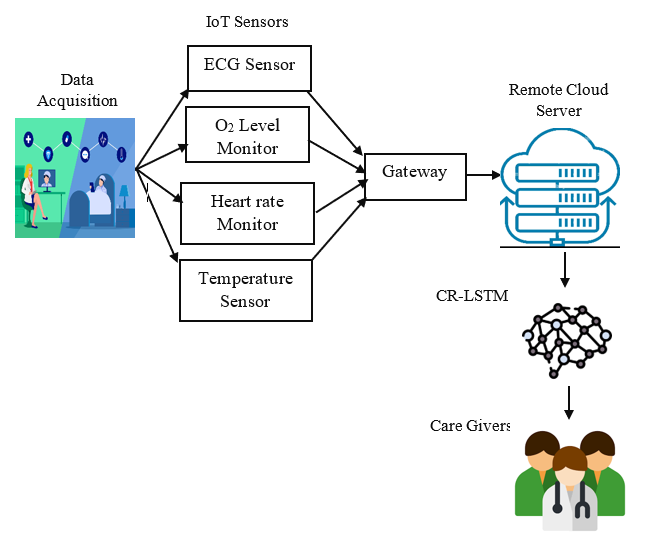A Context-Responsive LSTM based IoT Enabled E- Healthcare Monitoring System for Arrhythmia Detection
Main Article Content
Abstract
Detecting Arrhythmia, a life-threatening cardiac condition, in real-time is crucial for timely intervention and improved healthcare outcomes. Traditional manual methods for Arrhythmia detection using Electrocardiogram (ECG) signals are error-prone and resource-intensive. To address these limitations, this paper presents an automated system based on the Context Responsive Long Short-Term Memory (CR-LSTM) model for real-time Arrhythmia classification. The system leverages IoT technology to continuously monitor vital signs and effectively combines contextual information with temporal sensor data to accurately discern different types of Arrhythmias. The CR-LSTM model achieves an impressive accuracy of 99.72% in multiclass classification of Arrhythmias, making it a promising solution for dynamic healthcare settings and proactive personalized care.
Article Details
References
Tse, G. (2016). Mechanisms of cardiac arrhythmias. Journal of arrhythmia, 32(2), 75-81.
Ali, Z., Hossain, M. S., Muhammad, G., & Sangaiah, A. K. (2018). An intelligent healthcare system for detection and classification to discriminate vocal fold disorders. Future Generation Computer Systems, 85, 19-28.
Abdulmalek, S., Nasir, A., Jabbar, W. A., Almuhaya, M. A., Bairagi, A. K., Khan, M. A. M., & Kee, S. H. (2022, October). IoT-Based Healthcare-Monitoring System towards Improving Quality of Life: A Review. In Healthcare (Vol. 10, No. 10, p. 1993). MDPI.
Gondalia, A., Dixit, D., Parashar, S., Raghava, V., Sengupta, A., & Sarobin, V. R. (2018). IoT-based healthcare monitoring system for war soldiers using machine learning. Procedia computer science, 133, 1005-1013.
Vimal, S., Robinson, Y. H., Kadry, S., Long, H. V., & Nam, Y. (2021). IoT based smart health monitoring with CNN using edge computing. Journal of Internet Technology, 22(1), 173-185.
Akhtar, M. M., Shatat, R. S. A., Shatat, A. S. A., Hameed, S. A., & Ibrahim Alnajdawi, S. (2023). IoMT-based smart healthcare monitoring system using adaptive wavelet entropy deep feature fusion and improved RNN. Multimedia Tools and Applications, 82(11), 17353-17390.
Queralta, J. P., Gia, T. N., Tenhunen, H., & Westerlund, T. (2019, July). Edge-AI in LoRa-based health monitoring: Fall detection system with fog computing and LSTM recurrent neural networks. In 2019 42nd international conference on telecommunications and signal processing (TSP) (pp. 601-604). IEEE.
Senthilkumar, S., Samuthira Pandi, V., Sripriya, T., Pragadish, N, “Design of recustomize finite impulse response filter using truncation based scalable rounding approximate multiplier and error reduced carry prediction approximate adder for image processing application”, Concurrency and Computation: Practice and Experience, 2023, 35(8), e7629.
A. G, et al, "An Artificial Neural Network Classifier for palm Motion categorization based on EMG signal," (ICSES), Chennai, India, 2022, pp. 1-11, doi: 10.1109/ICSES55317.2022.9914097..
Haq, A. U., Li, J. P., Khan, S., Alshara, M. A., Alotaibi, R. M., & Mawuli, C. (2022). DACBT: deep learning approach for classification of brain tumors using MRI data in IoT healthcare environment. Scientific Reports, 12(1), 15331.
Ed-Driouch, C., Mars, F., Gourraud, P. A., & Dumas, C. (2022). Addressing the Challenges and Barriers to the Integration of Machine Learning into Clinical Practice: An Innovative Method to Hybrid Human–Machine Intelligence. Sensors, 22(21), 8313.
Sahoo, D. K. . (2022). A Novel Method to Improve the Detection of Glaucoma Disease Using Machine Learning. Research Journal of Computer Systems and Engineering, 3(1), 67–72. Retrieved from https://technicaljournals.org/RJCSE/index.php/journal/article/view/44
Tiwari, S., Jain, A., Sapra, V., Koundal, D., Alenezi, F., Polat, K., ... & Nour, M. (2023). A smart decision support system to diagnose arrhythymia using ensembled ConvNet and ConvNet-LSTM model. Expert Systems with Applications, 213, 118933.
Hammad, M., Abd El-Latif, A. A., Hussain, A., Abd El-Samie, F. E., Gupta, B. B., Ugail, H., & Sedik, A. (2022). Deep learning models for arrhythmia detection in IoT healthcare applications. Computers and Electrical Engineering, 100, 108011.
Pacheco, A. G., & Krohling, R. A. (2021). An attention-based mechanism to combine images and metadata in deep learning models applied to skin cancer classification. IEEE journal of biomedical and health informatics, 25(9), 3554-3563.
Yao, Q., Wang, R., Fan, X., Liu, J., & Li, Y. (2020). Multi-class arrhythmia detection from 12-lead varied-length ECG using attention-based time-incremental convolutional neural network. Information Fusion, 53, 174-182.
Samuthira Pandi, V., Singh, M., Grover, A., Malhotra, J., Singh, S, “Performance analysis of 400 Gbit/s hybrid space division multiplexing-polarization division multiplexing-coherent detection-orthogonal frequency division multiplexing-based free-space optics transmission system”, International Journal of Communication Systems, 2022, 35(16), e5310.
Kim, Y. K., Lee, M., Song, H. S., & Lee, S. W. (2022). Automatic cardiac arrhythmia classification using residual network combined with long short-term memory. IEEE Transactions on Instrumentation and Measurement, 71, 1-17.
Islam, M. R., Kabir, M. M., Mridha, M. F., Alfarhood, S., Safran, M., & Che, D. (2023). Deep Learning-Based IoT System for Remote Monitoring and Early Detection of Health Issues in Real-Time. Sensors, 23(11), 5204.
Moody, G. B., & Mark, R. G. (2001). The impact of the MIT-BIH arrhythmia database. IEEE engineering in medicine and biology magazine, 20(3), 45-50.

